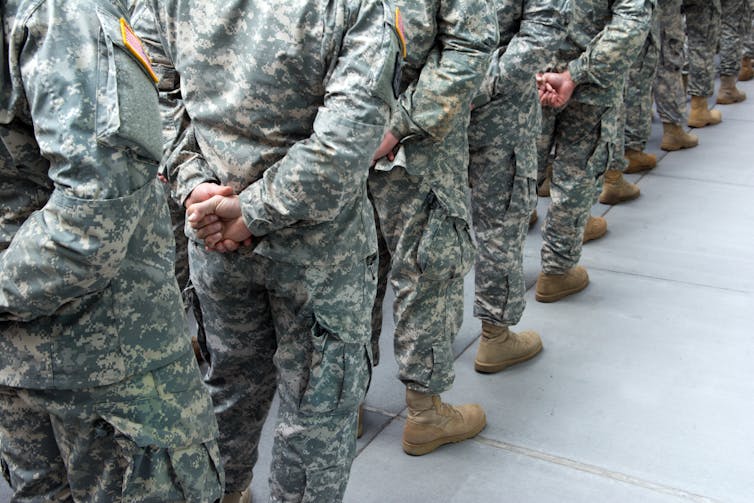When I looked at the Trump Virus map in Open Thread – 9/22/2020 (image below — although the title says Aug 22, 2020 the data is to Sept 22, 2020), a thought struck me — do you know what it is like to live next door to a country which professes such high regard for human life but does the opposite almost always? Do you know what it is like to live next door to a country whose so called leader belittles the leaders of other nations and many of his own people? Do you know what it is like to live next door to a country whose leader is a prolific liar and extremely corrupt?
US Cases: 7,047,643
US Deaths: 204,577
Plus thousands of Trump’s* GOP plague murders Republicans are hiding from us
Abortion and Healthcare — in 1973 Roe v Wade legalised abortion nationwide but now is at risk of being overturned by a very conservative SCOTUS at the petitioning of conservative and religious petitioners. This is an apple that evangelicals and fundamentalists have been wanting to pick for years.
You are not my moral compass.
Women do not make the decision to abort a foetus lightly and there are many reasons why she might make that decision. A baby in my family was born a number of years ago with no eyes, a double cleft palate, no ears and deaf, brain damaged — perfect from the shoulders down but the baby’s head was completely messed up. The original prognosis was that the baby would die within days. Had the mother known this in time, she would have had an abortion and I would have supported that decision.
In the US, such a child once born, has little support and likely limited healthcare options. For other children needing support to thrive, SNAP is being significantly cut back and possibly in danger of being cut all together. This lack of nutritious food will affect the physical and mental growth and health of children.
Healthcare has always been a problem in the US but with Trump, affordable care will be gone because of his spite for Obama and his policies. Trump has said so many times that his “bigger and better” healthcare plan is coming. After almost 4 years, nothing is in sight! Tens of millions of Americans will be without any healthcare. Of course, Republicans are not assessing any healthcare plans for those not covered by workplace plans because they are enthralled by large insurance corporations (think political contributions) and do their bidding. With the pandemic, many Americans have lost their jobs and with it their healthcare.
Education — With the Trump administration, a balanced public education system is almost gone. Betsy DeVos is seeing to that and Trump is not far behind with his new flag hugging “indoctrination” thoughts. I saw a reference to the education of children by Mao Zedong where the children were forced into indoctrination classes as is still done some 43 years after his death. In Nazi Germany in the early 20th century, there were the Hitler Youth, indoctrinated in Nazi ideology.
“The members of the Hitler Youth were viewed as ensuring the future of Nazi Germany and were indoctrinated in Nazi ideology, including racism.[14]” [Wikipedia]
I wonder if Trump would force children to wear red/white/blue neckerchiefs as Mao forced Chinese children to wear red neckerchiefs and the Hitler Youth had their red neckerchiefs with their emblem? With Republicans continuing in power, I can see the literacy rate dropping while problem solving skills and critical thinking being discouraged. Must not have people, other than the rich and white, capable of intelligent thought because they just might help American society. I think of a Canadian bumper sticker from several years ago that said “The government does not like competition!” Trump and Republicans cannot fight themselves out of a wet paper bag fairly or even at all unless they cheat. Only the rich will be able to get a decent education.
Death Penalty — How is the death penalty consistent with a pro-life stance? I won’t go into this other than to say that the death penalty is not pro-life.
Pandemic — The actions, or should I say the inactions, of Trump and Republicans on the COVID-19 pandemic with its more than 200,000 deaths is despicable. Bill Gates opined recently that repatriating Americans who were overseas at the beginning of the pandemic without adequate (read that as NO) precautions in place, likely exacerbated the spread of the virus, and he is correct. I know that Trump likes to blame China for all the problems, but what did HE do once he knew about it. NOTHING!!! Thanks to author/journalist Bob Woodward, we have Trump on tape in his own words saying that he wanted to play down the severity of the virus, and he still is doing that verbally, but also demonstrating his disregard by holding large rallies with no social distancing and no masks. He said he did not want to panic people. Bullshit!!! More likely, he did not know what to do and thought he would look weak if he asked for the input of infectious disease experts. Trump has directly caused the deaths of over 200,000 people and rising. As to overall healthcare, Trump is arguing in the Supreme Court to overturn the Affordable Care Act (Obamacare) even in the midst of a pandemic which would leave tens of millions of people without healthcare and no replacement plan in place which is, I believe, his plan from the start.
Racism and Bigotry — Racism has been a problem, a BIG problem, in the US since before the country was established and it has continued unabated. Thank heavens for Rosa Parks, Elijah Cummings, Martin Luther King Jr, John Lewis and the many others who fought and continue to fight racism and demand equal rights for ALL people. No matter the colour of skin, the religion, the ethnicity, sexual orientation, or language spoken, ALL Americans are equal. This was clearly set out in the Declaration of Independence.
“We hold these truths to be self-evident, that all men are created equal, that they are endowed by their Creator with certain unalienable Rights, that among these are Life, Liberty and the pursuit of Happiness.” [Wikipedia]
And yes, the racism is systemic whether people want to acknowledge that or not. Part of that fight resulted in the Civil Rights Act of 1964 and the Voting Rights Act of 1965. Unfortunately, some of that has been undone by SCOTUS decisions for petitions from woefully misguided persons, dare I say racist persons. Of course today, the chief cheerleader is the Squatter in the WH, the unpatriotic flag hugger who thinks there were “very fine people” on both sides in Charlottesville a few years ago. Bullshit!!!
With the passing of Justice Ruth Bader Ginsburg on 18/09/2020, Trump, aka the Squatter in the WH, and Senate Republicans are pushing for a fast confirmation of a replacement justice who will be undoubtedly very conservative. When it comes to Trump, forget about justice being blind! Republicans were willing to leave Antonin Scalia’s position vacant for 10 months because it occurred in an election year and they felt the new president should make the nomination. RBG passed away 6-7 weeks before the election but Republicans have changed their minds. Why? They are afraid that Trump may be defeated (please let it be so!) and they would not be able to continue to stack the court with conservatives or get satisfactory decisions for those who support them. As I said, forget about justice being blind! Add to this that COVID-19 has added a dimension to voting that has not existed previously — extensive mail-in voting — which Trump, without evidence, as declared fraught with fraud. With a larger conservative contingent at SCOTUS, Trump feels his chances of re-election, even if the decision goes to the court, are all but assured. Trump, impatient toddler that he is, also wants to know who the winner is on the night of 03/11/2020, election night, but all mail-in ballots may not have been counted. This shows that Trump is again, or should I say still, downplaying the virus. He should pay as much attention to Russian interference in the election. This of course has nothing to do with what the people want or need. Let’s not forget that Trump was the loser of the popular vote in 2016 by 2.9 million votes. The US has had minority governance for almost 4 years with a narcissistic sociopath at the helm and it shows. You wonder why other countries laugh at the US and pity it!
Military — Let’s not forget the recent debacle of Trump as Commander-in-Chief of the military calling soldiers who were killed in action or captured “suckers” and “losers”. Is that how a leader supports the troops? Or Trump’s treatment of Gold Star family of Khizr Muazzam Khan and Ghazala Khan, the Pakistani American parents of Army Captain Humayun Khan, who was killed in 2004 during the Iraq War. Commander-in-Bone Spurs knows nothing of patriotism! It is all a flag hugging show. We know that but he thinks people don’t care. He went after Senator John McCain this way and today, John’s wife, Cindy McCain, came out in support of Joe Biden.
Religion — Two things I want to mention here. First, no authentic Christian would clear a path through peaceful protesters using violence so he could have a photo op holding a Bible upside down. No authentic Christian would treat migrants the way Trump has, separating families, creating utter chaos at the southern border. Secondly, no authentic Christian would label all Muslims as terrorists and ban them from entering the country. There are more domestic terrorists in the US than Muslim terrorists. Besides, the 2nd Amendment to the US Constitution guarantees the freedom of religion which also means freedom from religion, something many on the right seem to forget. It seems to me that that part of the amendment is interpreted by evangelicals and fundamentalists as the freedom of religion as long as it is their brand of Christianity. “One nation under God” and “In God We Trust” — give me a break! God is not a cudgel.
Treaties — Below is a list of United Nations treaties which the US has not ratified or not signed as noted in Wikipedia. I have highlighted some which, on the surface, directly impact people including US citizens. There could be a number of reasons for not signing or ratifying them but to me, this is an indication of the priorities of the US government.
1981 – Occupational Safety and Health Convention, 1981, not ratified
1989 – Second Optional Protocol to the International Covenant on Civil and Political Rights, not signed
1989 – Convention on the Rights of the Child, signed but not ratified
1989 – Basel Convention, signed but not ratified
1990 – United Nations Convention on the Protection of the Rights of All Migrant Workers and Members of Their Families, not signed
1991 – United Nations Convention on the Law of the Sea, not signed
1992 – Convention on Biological Diversity, signed but not ratified
1994 – Convention on the Safety of United Nations and Associated Personnel, signed but not ratified
1996 – Comprehensive Test Ban Treaty, signed but not ratified
1997 – Kyoto Protocol, signed with no intention to ratify
1997 – Ottawa Treaty (Mine Ban Treaty), unsigned
1998 – Rome Statute of the International Criminal Court, unsigned [2]
1999 – Optional Protocol to the Convention on the Elimination of All Forms of Discrimination against Women, not signed
1999 – Criminal Law Convention on Corruption, signed but not ratified
1999 – Civil Law Convention on Corruption, not signed
2002 – Optional Protocol to the Convention against Torture, not signed
2006 – International Convention for the Protection of All Persons from Enforced Disappearance, not signed
2007 – Convention on the Rights of Persons with Disabilities, signed but not ratified
2008 – Convention on Cluster Munitions, not signed
2011 – Anti-Counterfeiting Trade Agreement, signed but not ratified
2013 – Arms Trade Treaty, signed but not ratified
2016 – Trans-Pacific Partnership, signed but not ratified
2017 – Paris Agreement, signed but not ratified [and in 2017 ceased participating]
I might sound anti American and in some ways I might be. I know I am preaching to the choir here at Politics Plus. I also know that my ire is directed at Trump, Republicans and a minority of the American people. The vast majority are good people who need to find their voice. I also know that my country, Canada, is not without its own faults. No country is in that position. However, when wherever you turn the US is being held up as the “greatest nation on earth”, a beacon in the darkness, it is time the US government acted like it. When wherever you turn Trump is being touted as the leader of the free world, I say bullshit! That is a particular bug-bear of mine. First he has to be a leader, an enabler of sound policies that serve ALL Americans, and he has to be sane. In my opinion, he is neither of these. Trump is a scared little boy who pouts and stamps his feet if he does not get his way. He is a demagogue and a fascist who, if not checked, will destroy the country completely. Recovery from Trump will not be easy and it won’t be quick. It will take the American people uniting to go forward.
OK, I am stepping down off my soapbox! Thanks for letting me rant.















